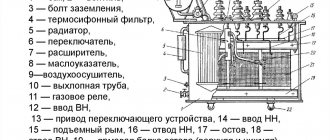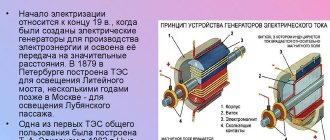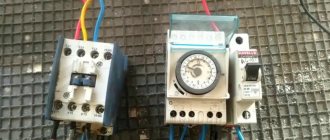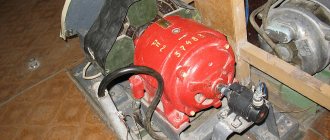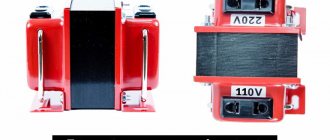What is phase and phase shift
From the name of the device you can guess that the phase is measured. In fact, it is a phase shift. In the electrical power industry, this word denotes two different concepts at once - a physical conductor on which there is potential (voltage), and the state of the level of this potential or current strength at a specific moment in time.
From the school curriculum, everyone remembers the graph of changes in alternating voltage and current in the form of sinusoids. Ideally, they are completely identical. But in practice this is not always done.
When connecting equipment with high inductance (electric motors or high-power transformers) to the network, the rate of current rise lags behind the voltage. This is called a phase shift.
Briefly about the phase meter
When the device is connected to the measurement circuit, it is connected simultaneously to the current and voltage circuits. If it is necessary to work with networks that have three voltage phases, then the device is connected simultaneously to all these voltage phases. The current connection is made to the secondary windings of the transformer.
The device uses a simplified connection diagram. Therefore, it will not be difficult to figure out the purpose of the phase meter yourself. The current connection is made in two phases, so the third phase is determined based on the addition of vectors of only a pair of currents (meaning the measured phases). Also, the purpose of the phase meter is to measure the power factor. This device in simple language is also called a cosine meter.
At the moment, there are two types of phase meters, the scope of which is to determine the power factor. This is a digital and electrodynamic device. Let's look at them in more detail.
Electrodynamic
An electrodynamic phase meter is also often called an electromagnetic phase meter. The design of this type of meter is based on a circuit of the simplest type with a ratiometric direction mechanism, which makes it possible to carry out work on measuring phase shifts. This phase meter contains a pair of frames rigidly connected to each other. There is an acute angle between them equal to 60 degrees. The frames are installed on axes that are fixed in supports, so there is no counteracting moment of a mechanical nature in the device.
There are certain conditions that can be set only by shifting the phases of the currents in the circuits of such frames. The moving component of the phase meter rotates by an angle equal to the angle that characterizes the phase shift index. The linear scale on the device makes it possible to record the result of the measurement.
Let's consider the operating principle of an electrodynamic phase meter. Such a device has a fixed coil with current and a pair of movable coils. Each of the moving coils has its own currents flowing, creating magnetic fluxes in the stationary and moving coils. Therefore, it can be assumed that the fluxes of the coils that interact generate a pair of rotating moments. The magnitudes of these moments are largely directly dependent on the location of the pair of coils relative to each other, as well as the angle through which the moving components of the phase meter rotate. These moments are directed in different directions, opposite to each other. The average values of these moments depend on the currents that flow in the moving coils and on the current in the fixed coil. There is also a dependence on the design of the coils and on the phase shift angles between the coils.
Thus, the moving component of the phase meter will rotate under the work of these moments until a state of equilibrium is obtained, which will be caused by the equality of the moments themselves as a result of the rotation. The very scale of such a device can have a gradation in the system of power factors, which will be convenient for carrying out a number of measurements.
The main disadvantage of electrodynamic phase meters is the direct dependence of the readings obtained on the frequency value. In addition, there is also a large power consumption from the source that is being studied
Digital
This type of phase meter is manufactured in several ways. For example, a compensation-type phase meter has one of the highest degrees of accuracy, despite the fact that it is performed manually. The operating principle of a compensation phase meter is completely different. Such a device has a pair of sinusoidal voltages. In this case, the purpose is to determine precisely the phase shift between them.
Initially, the voltage is supplied to the so-called phase shifter, controlled by a special code directly from the control device. The shift between phases will change gradually until it reaches a state of in-phase. During adjustment, the sign of the shift of these phases is determined using a phase-sensitive detector.
The output signal is fed directly from this detector to the control device. The control algorithm is implemented directly by the pulse coding method. After balancing, the phase shifter input code will show the amount of shift between the phases. This is its basic operating principle.
Today, digital phase meters use in their work a principle based on discrete counting. This method works in two stages. Initially, a process occurs associated with the conversion of the phase shift into an indicator of a signal having a certain duration. Then the length of this pulse itself changes using discrete counting. This device includes a converter for a phase shift into a pulse, a time-type selector, a discrete pulse shaper, as well as a counter and a control device. It is important to know that digital phase meters have a smaller measurement error, because calculations are carried out over several periods.
Reactive power and cosine phi
This phenomenon is explained by the fact that inductance prevents an increase in current strength, and a decrease, on the contrary, slows it down, and when the voltage is zero, it releases it back into the network.
At this moment, the current returns to the supply transformer and is partially spent on heating the wires. These wasted losses are called reactive power, which creates additional load on the network and reduces the actual power of the connected equipment.If you look at the graph of such a process, you can see that the angle between the current and voltage sinusoid changes in proportion to the lag.
The numerical value of the cosine of this angle (from -1 to +1) corresponds to the ratio of reactive power to total power, and is called the power factor or cosine phi. It shows how much of the incoming current is used for its intended purpose.
The main task of the phase meter is to measure this parameter. In a three-phase network, it is possible to determine the relative phase shift under uneven load.
Operating principle of the phase meter
Phase meters operate using the following principle: thanks to an adjustable phase shifter and a sound generator, 2 sinusoidal voltages are generated, shifted by 90°. They are fed to the vertical and horizontal deflection plates of the oscilloscope, generating a circular scan.
In this case, one of the voltages is connected to the input of the quadripole under study. And an electronic relay is connected to the output. The output differentiated pulses of the electronic relay modulate the electron beam of the oscilloscope so that a mark appears on the visible part of the tube screen, the location of which is determined by the phase shift brought by the quadripole. The reference point is established by connecting the input of the electronic relay to the input of the quadripole, and using an optical device, the angle between the reference point and the mark is measured.
You can watch an interesting video about the operation of the phase meter below:
Connection
As a rule, the instructions for using the phase meter describe in detail the connection method. In its absence, it is not very difficult to do it yourself.
It is required to connect the terminals of the device with the corresponding symbols and connectors to the voltage and current circuits (to the phase wire break).
- Properties, scope of application of Paroc basalt insulation
- Mitsubishi Electric: company history
Dosing pumps - device, types and applications
As a last resort, you can always use the Internet and find the necessary description.
User manual
To understand the use of the phase meter, the main attention is paid to the operating instructions (included with the device). There are a few steps you need to take before you begin.
First, you should make sure that the operating conditions correspond to those recommended by the manufacturer, and the frequency range is in accordance with the metrological characteristics. After this, the circuit itself is assembled.
The phase meter is operated according to the following algorithm:
- First you need to read the instructions that come with the product. The document reveals the nuances and rules for using the device.
- Using the corrector, the arrow is set at the 0 mark.
- Make sure the buttons are not actuated.
- Connect the input probes to the required connectors.
- Press the key that supplies power to the device. Pay attention to the lighting of a special indicator.
- Wait a while for the device to warm up well. This is necessary to achieve maximum measurement accuracy. On average, the exposure time should be about 10-15 minutes.
- Find the input voltage.
- Press the button depending on the choice of external voltage and set the required frequency range.
- Click “>0 POPULAR WITH READERS: How to check the electric motor for serviceability?
Criterias of choice
First you need to decide what the device is needed for, where and how it will be used. Will it only be recording the presence and magnitude of reactive power in stationary conditions and in a standard power grid, or will accurate measurements over a wide range be required for calculating device parameters and designing power supply systems.
In the first case, an inexpensive analog phase meter would be a good solution. For the second, one of the digital versions is more suitable.
Depending on financial capabilities, this can be a small multifunctional device with the required accuracy class or a microprocessor complex with software and a set of service applications.If you need to take measurements in different places, there are several small, discrete mobile devices on the market.
For a qualified energy specialist, choosing the appropriate device will not be difficult.
For those less knowledgeable, you just need to take into account the above criteria, evaluate the price-quality ratio, the brand awareness of the manufacturer and the reliability of the equipment supplier.
In any case, when choosing a phase meter, you should be guided by expediency and common sense, so as not to overpay for unnecessary functions, a high accuracy class that is not required, or “beautiful” options.
Basic principles of classification of phase meters
As an electrical measuring device, phase meters are classified according to several criteria:
- Based on the design:
- analog (electromechanical, electrodynamic);
- digital (electronic).
- By number of phases:
- single-phase;
- three-phase.
Single-phase instruments are designed to determine the phase angle in single-phase circuits, and 3-phase instruments allow measurements to be made in a full-wire three-phase circuit. Structurally, such devices are not much different, the difference is that in a single-phase device all the moving frames are located relative to each other at an angle of 90 degrees, and in a 3-phase device - at 60 degrees.
Measuring cos φ at industrial frequencies is carried out using electromechanical devices with direct reading, which use a logometer (ferrodynamic, electromagnetic, induction, electrodynamic) as a measuring mechanism. The deviation of the moving part of the ratiometer is determined by the phase shift of the corresponding current and voltage.
For a wide range of frequencies, electronic counting meters of time intervals from the moment of passage of related phase oscillations through 0, and graduated phase shifters in an ensemble with indicators of zero phase difference (for example, phase detectors) are used as a phase meter.
Electronic type phase meters are made in the form of a separate unit. Its front panel displays a microammeter, the scale of which is graduated in degrees, a power supply switch, and input terminals for the measured signals.
All components of the device are mounted on a printed circuit board made of foil fiberglass and secured to the measuring clamps of a microammeter.
The board is connected to the input terminals using a shielded wire, which ensures high noise immunity.
The error of the electromechanical phase meter is 1-3°, electronic - 0.06-0.1°.
Photos of phase meters
Did you like the article? Share

1+


